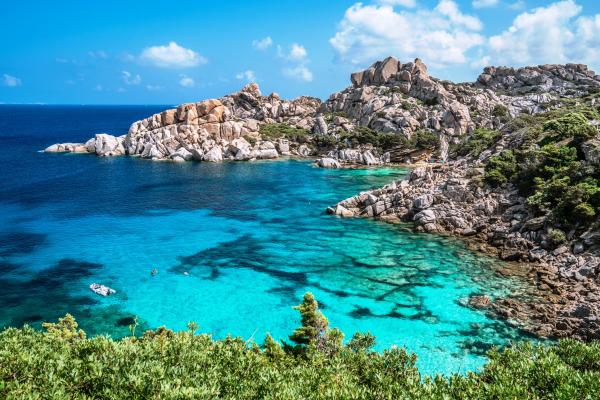It lies at the foot of the promontory that stretches to the northernmost point of Sardinia, facing a turquoise sea reflecting shades of emerald green, with the splendid northern islands of the Park of the Maddalena Archipelago in front of it. The beach of Marmorata occupies a stretch of coast at the base of Capo Falcone, in the territory of Santa Teresa Gallura, five kilometres from the residential area of the little Gallura town. In reality, the long stretch of soft, white sand - with some hints of pink near the shoreline - is divided into two parts by a stretch of reef, so there are really two beaches. The smaller beach, to the north, is known as Marmoratina or La Laurina. The sea and the landscape, however, share the same beauty: you can admire waters with spectacular shades of emerald green and a few granite rocks appearing on the surface. On the horizon, you can see the most distant islands of the Maddalena archipelago: Budelli, Razzoli and Santa Maria. Then, towards the promontory, you’ll notice the islet of La Marmorata: it can be reached aboard a pedalo and, on it, you can see what remains of a granite quarry from the Roman era.

Beach
White sand, a sea dotted with rocks and islets, sports and attractions characterise this Santa Teresa Gallura beach, in the north-east of Sardinia
White sand, a sea dotted with rocks and islets, sports and attractions characterise this Santa Teresa Gallura beach, in the north-east of Sardinia
See this place because...
You can relax on the beach or devote some time to one of the countless activities that the beach offers, including water sports, trekking and the discovery of ancient military constructions
Nearby
Come arrivare
La Marmorata is found in the place called La Marmorata, in the commune of Santa Teresa Gallura. The beach has quite coarse-grained cream-coloured sand, verging on grey. It can be reached along the SS 131 bis, from which 5 kilometres after Santa Teresa Gallura, you take a left. Turn right just before the holiday village and park after a couple of hundred metres.
Ti piace questo luogo? Santa Teresa Gallura potrebbe essere la tua meta ideale.
You may also like
More attractions in the vicinity












